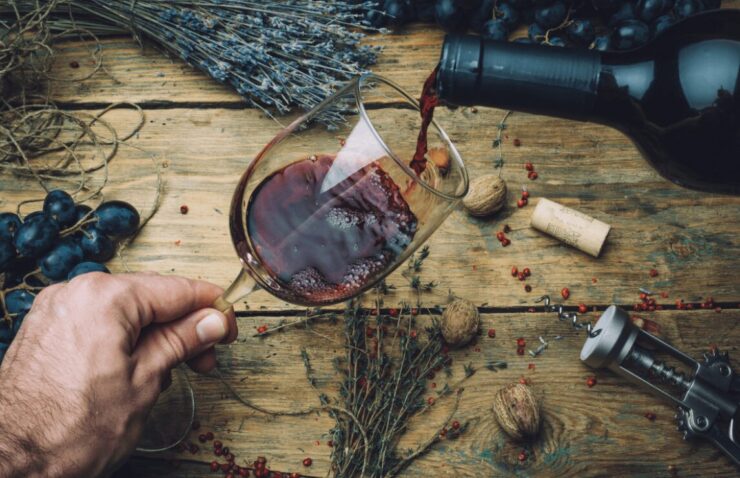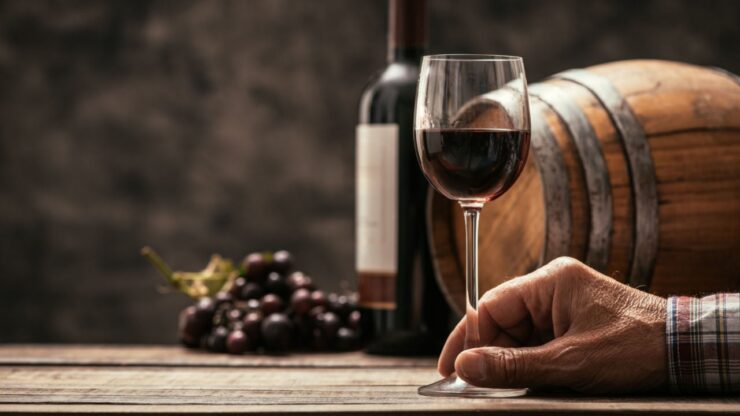The allure of red Merlot wine can be traced back to 18th-century Bordeaux, a region steeped in wine-making tradition and blessed with favorable conditions for viticulture. The name Merlot is thought to derive from the French word ‘merle,’ referring to the blackbird, perhaps an allusion to the grape’s dark, almost black color. Though initially used as a blending grape in the famed Bordeaux blend, Merlot would soon command the spotlight and establish a reputation for its own distinctive characteristics.
Characteristics and Flavor Profile of Red Merlot: Understanding its Unique Attributes

Red Merlot wine allure is inextricably linked to its unique flavor profile and characteristics. Medium to full-bodied, it often exhibits softer tannins compared to its Bordeaux sibling, Cabernet Sauvignon. This makes Red Merlot wine generally smoother and easier to drink earlier, endearing them to a wide array of palates who can appreciate its delightful qualities when they visit this site.
Merlots are celebrated for their rich bouquet of flavors. Depending on the growing conditions and wine-making techniques, they can range from ripe, juicy fruits like plums, black cherries, and blackberries to savory notes of tobacco, bay leaf, and black pepper. Old World Merlots tend to lean towards earthier profiles, while New World expressions often spotlight lush, ripe fruit flavors. This complex play of flavors continues to enthrall wine enthusiasts worldwide.
Color is also a distinctive attribute. The wine’s visual allure is unveiled through its deep ruby hue that can progress towards garnet as it ages. This beautiful spectrum of color further enhances the drinking experience, proving that the appeal of Merlot engages all senses.
Vineyards and Regions: Exploring the Best Terroirs for Production

Grapes thrive in a variety of climates and soils, giving rise to diverse expressions of wine. Bordeaux, specifically the Right Bank regions of Pomerol and Saint-Émilion, is home to some of the world’s most illustrious wines. The cool climate and clay-heavy soils here favor Merlot’s early-ripening nature, producing wines of exceptional depth and complexity.
In the New World, California’s Napa Valley and Sonoma County are renowned for their Merlot production. Here, the warmer climate and diverse soils give rise to vibrant, fruit-forward wines. Meanwhile, Washington State, with its cooler nights and longer growing season, produces Merlots with a great balance of fruit and acidity, often compared to those from Bordeaux.
Chile and Australia have also made their marks on the global scene. Chile’s Central Valley is acclaimed for Merlots with an appealing mix of fruit and herbal notes, while Australia’s cooler regions like Margaret River and Yarra Valley produce wines with a distinctly plush texture and rich, berry flavors. The diversity of terroirs contributing to Merlot’s expressions is a testament to the grape’s adaptability and allure.
Production Process: From Grape to Glass

It starts in the vineyard, where the early-ripening grapes are carefully monitored to ensure optimal ripeness. Once harvested, the grapes are de-stemmed and crushed to release their juices, starting the fermentation process.
The fermentation, usually in stainless steel or oak vessels, transforms the grape sugars into alcohol. The winemaker’s artistry comes into play here, determining factors like fermentation temperature and duration, which will shape the wine’s character. Following fermentation, the wines are typically aged in oak barrels. The choice of oak, its age, and toast level, imparts additional flavors and help soften the wine’s tannins.
Before bottling, the wines may be subjected to fining and filtering to enhance clarity and stability. The result is a range of Merlot wine, from young, vibrant, fruit-forward styles ready for immediate consumption to more complex, full-bodied versions that reward patience with additional aging.
Discovering Complementary Flavors
Part of the appeal of red Merlot lies in its food-friendliness. Its balance of fruit, acidity, and tannins makes it a versatile companion at the dining table. For a classic pairing, try a robust Merlot with roast lamb or beef, where its ripe fruit flavors and supple tannins perfectly complement the rich meat.
Merlot’s subtle earthy notes make it a fantastic match for mushroom-based dishes, while its underlying sweetness can echo the caramelization of grilled vegetables or the sweetness of slow-cooked stews. For cheese lovers, it pairs beautifully with a wide range of cheeses. Opt for creamy blue cheeses with fruitier Merlots, while hard, aged cheeses like Gouda or cheddar can stand up to a full-bodied, oaky Merlot.
Tasting Techniques: Enhancing the Sensory Experience

To fully appreciate the allure of Merlot, certain tasting techniques can enhance the sensory experience. Start by observing the color and viscosity of the wine. A young Merlot will have a deeper color, while an aged one will show a lighter, more brick-red hue.
Next, swirl the wine in your glass to release its aromas. Take a moment to breathe them in, identifying the fruit, earthy, or oaky notes. The initial sip will reveal the wine’s primary flavors. Allow it to coat your palate to experience the balance of fruit, acidity, and tannins.
Lastly, pay attention to the finish – the flavors that linger after swallowing. A high-quality wine will often have a longer, more complex finish. Remember, tasting is a personal and subjective experience. Take your time, savor each sip, and most importantly, enjoy the process.
Unveiling Development and Maturation Potential
Merlot wine, particularly those from esteemed regions like Pomerol and Saint-Émilion, have an excellent potential for aging. Over time, the wine’s flavors integrate and evolve, revealing new layers of complexity. The fruit flavors may soften and become more subdued, making way for secondary and tertiary notes like leather, tobacco, and truffle.
When cellaring Merlot, proper storage conditions are key. The wine should be stored at a consistent temperature, ideally between 12-15°C (54-59°F), and away from light and vibrations. The bottles should also be kept on their sides to prevent the cork from drying out.
It’s important to note that not all Merlots will benefit from extended aging. Many New World Merlots, for instance, are made to be enjoyed while young and fresh. If in doubt, seek advice from a trusted merchant or sommelier.
Conclusion
Every bottle of Merlot has a story to tell – of its origin, its makers, and the unique conditions of the year it was made. Unraveling these stories is part of the wine’s allure, inviting us on a sensory journey that transcends borders and connects us with different cultures and traditions. The beauty of Merlot lies in its diversity, its adaptability, and its steadfast ability to both comfort and surprise.

